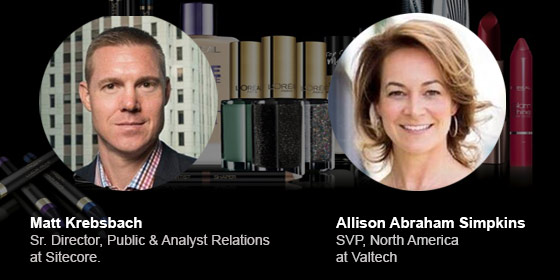L’Oréal Deepens Brand Loyalty with Digital First Attitude
By Gary Eisenstein
October 15, 2018
Agile delivery model, Allison Abraham Simpkins, brand experience, content management system, digital marketing, digital transformation, L’Oréal, localization, Matt Krebsbach, Sitecore, Valtech
- Company: L'Oreal S.A.
- Founded in: 1909
- Industry: Retail, Personal Care
- Headquarters: Clichy, France
- Employees: 89,300 (2016)
- CEO: Jean Paul Agon
- Revenue: $26.02 Billion EUR (2017)
- Website: www.loreal.com
L’Oréal started down the path of obtaining digital maturity in 2017 by committing to a considerable degree of organizational, operational and technological changes. This type of change is often refereed to as a “digital transformation.” After a worldwide search, L’Oréal selected Sitecore to provide the digital marketing platform and Valtech as its business transformation and Sitecore integration partner.
Although I'm very familiar with the experience management platform Sitecore and their operations since the company’s inception in 2001, I had very little knowledge of Valtech until they acquired Toronto-based, Non-Linear Creations in 2017. Since then, I have gained a far better understanding of this global digital agency and their unique portfolio of work centered around the business challenges we are all faced with in the ever-evolving digital transformation journey.
 L’Oréal had 1-billion customers interacting with 3,000 different websites every day, so it was imperative that the company improve their consumer's online experience while delivering a consistent branding message to stay competitive in the digital landscape. The objective was to refresh and relaunch 600-websites for 15-brands over a 3-year period. This project would be Sitecore’s largest implementation in the company’s history. L’Oréal also had opportunities to develop new e-commerce channels, personalize the shopping experience, and increase revenue through cross-selling.
L’Oréal had 1-billion customers interacting with 3,000 different websites every day, so it was imperative that the company improve their consumer's online experience while delivering a consistent branding message to stay competitive in the digital landscape. The objective was to refresh and relaunch 600-websites for 15-brands over a 3-year period. This project would be Sitecore’s largest implementation in the company’s history. L’Oréal also had opportunities to develop new e-commerce channels, personalize the shopping experience, and increase revenue through cross-selling.
L’Oréal, the 109-year old organization, armed with a digital first attitude approached Sitecore and Valtech seeking guidance and solutions to cost effectively localize products and services, and scale for future growth. This is where the story became impressive for me. In an effort to deepen brand loyalty and improve the online experience for their billion-plus consumers, they wanted to become the number-one digital beauty brand in the world... from “business as usual” to “digital first.” Easier said than done, as many historic business as usual companies of similar size and brand recognition failed to make this critical transformation… Kodak, Blockbuster, Toys “R” Us, Tower Records and Compaq come to mind.
Recently, I had the opportunity to interview both Allison Abraham Simpkins at Valtech and Matt Krebsbach at Sitecore for this CMSC case study article. The insights I gathered from my discussion with Allison and Matt helped me truly understand how extraordinary this project is as a template for big brands to follow.

|
What CMS platform was L’Oréal using prior to Sitecore and what was the deciding factors of how L’Oréal ended up selecting Sitecore?
|
|
Matt: L'Oreal consolidated more than 10 technologies—including an existing in-house CMS—in favor of Sitecore Experience Platform. L’Oreal selected Sitecore for a variety of reasons—not least of which being the ability to leverage customer insights in real time—but a key reason is Sitecore’s ability to support a globally consistent online brand experience and cost-effectively localize that experience across 60 country subsidiaries (i.e., create unique local digital experiences on the top of master websites, which is a significant benefit to L’Oreal’s local partners and Web agencies). L’Oreal also selected Sitecore because it is a flexible and scalable platform that allowed the company to drive significant operational efficiencies company-wide, which allows L’Oreal to accelerate time-to-market for new products.
|
|
How was Valtech brought in to the project and what was your experience going through the proposal stage with L’Oréal and winning the contract?
|
|
Allison: We were already an existing partner with L’Oréal and had previous project work experience with L’Oréal Professional using Sitecore and in this engagement we created the foundation for what now is called the WSF by showing that we could develop re-usable components, improve speed of localization and the roll-out. During the RFP phase for the WSF L’Oreal invited, mostly existing partners to participate. It was a challenging period for us during the proposal stage. We had to a lot of work to perform in a very short timeframe, and the L’Oréal request for proposal was really into the fine details of the architecture, governance and project set-up. As part of our proposal response Valtech included a few proof-of-concepts on the architecture and dev-ops set-up.
|
|
What were the top-5 requirements for the project?
|
|
Matt & Allison: Reduce time to market, improve quality, efficient localization (country roll-out), improve re-use across brands, improve digital marketing capabilities.
|
|
How did the initial requirements stage and initial discovery meetings go with L’Oréal?
|
|
Allison: L’Oréal primary concerns during the initial discovery stage were on the ability of Sitecore and Valtech to scale the program at the necessary speed: from 0 to 100 employees in 3-different regions. How do we make sure that this is done while at the same time guaranteeing quality. Part of this work we did during the RFP stage. Next to this we had an 8-week pressure cooker with different streams: Architecture (Sitecore, front-end, dev-ops), governance, and project roll-out where we detailed the approach. Our concerns (Valtech & Sitecore) was the business transformational part, the translation of the transformational goals into the program, ensuring buy-in from all stakeholders and making sure that those transformational goals were met.
|
|
What hurdles did you overcome during the implementation stages?
|
|
Allison: Ensuring that the component library grows fast enough and that re-use is optimized as much as possible. We have multiple teams running at the same time, implementing new components and re-using components. Organizing timely knowledge sharing to drive re-use is one of the bigger hurdles.
|
|
Knowing that the overall contract was for the rollout of 600-websites from 15-different brands, how did Valtech go about prioritizing such a colossal undertaking?
|
|
Allison: This was a joint effort with L’Oréal. We had a clear roadmap on which brands to deploy first, and then a roll-out roadmap for each brand. We started with low complex brands and moved slowly to more complex sites and brands.
|
|
What sites and brands have you completed, and what’s the timeline for the remaining sites to go live?
|
|
Allison: We are on track with the roadmap, as set out in the program. We have done 6-brands, 2-brands are in progress. The other brands are on the roadmap for the remainder part of the program. The same for the roll-outs we have rolled-out 100+ country sites, and on track in the roadmap.
|
The Platform Solution
After a worldwide search, L’Oréal chose Sitecore to provide the digital marketing platform. The company had 1-billion customers interacting with their 3,000 different websites every day. There was a desire to improve the consumer's online experience while delivering a consistent branding message across 60 country subsidiaries. L’Oréal also had opportunities to develop new e-commerce channels, personalize the shopping experience, and increase revenue through cross-selling.
- Sitecore Commerce
- Sitecore Experience Database
- Sitecore Connect for MS Dynamics 365
- Sitecore Experience Platform (XP) on MS Azure PaaS
The Business Transformation Team
Valtech and Sitecore worked together to provide L'Oréal with a customized solution that would allow the beauty brand to quickly create new sites using a site cloning tool. Best described as a toolkit, the solution includes multimedia content and allows each country’s editor to build pages that meet local needs but still adhere to company branding and objectives.
- Improved Page Load Times
- Lower Capital Costs & Tech Admin
- Unified Digital Presence Across Brands
- Consolidated 10+ Technologies to One
The Results
L'Oréal has enjoyed great success as a result of the project, including significant cost savings and faster innovation for its customers worldwide. Today, the company can launch a new website in just 10 days, the number of unique monthly visitors has increased by 35%, and customer satisfaction is up by 40%. One unexpected benefit is the effect the platform has on the ways countries interact with one another, giving rise to fresh interactions and new synergies within the company itself.
We now have a worldwide website factory marketplace to make it easy for every brand and country to concentrate on providing the best experience for our consumers.
~ Lubomira Rochet, Chief Digital Officer of L’Oreal Global.
600Websites for 15 Brands
3 secPage Load Time
10Consolidated Languages
Valtech and Sitecore worked together to provide L'Oréal with a customized solution that would allow the beauty brand to quickly create new sites with multimedia content, allowing each country’s editor to build pages that meet local needs but still adhere to company branding and objectives. Design and delivery centers were set up in the Americas, Europe, and Asia to ensure the application and design works at the local level. From the start, Valtech recommended the move to an Agile delivery model and L'Oréal agreed. Valtech provided Agile training for 80+ L'Oréal employees and guided the company through the new process, providing a comprehensive user guide, training, change management solutions, and global governance initiatives to support the transition to the new platform.
L’Oreal has already experienced success with the first round of new websites launched, while the roll-out of the other websites are well underway. One of these sites launched with a new augmented reality “Try-On” tool that provides consumers with an innovative way to experience more than 300 of the brand's blush, eyeshadow, eyeliner, lipstick, lip Liner and hair color shades directly from the www.lorealparisusa.com site. The virtual tryout interface features photo-realistic color simulation, allowing consumers to virtually try-on hundreds of L'Oréal beauty products online in real-time, allowing consumers to be their own makeup designer.
Today, beauty consumers that are passionate about their favorite brands can now enjoy a rich, interactive, digital relationship with L’Oreal. Consumers want to be co-creators of a brand identity through digital experiences, and that is exactly what Valtech and Sitecore plan to deliver… a globally consistent online brand experience while also providing cost-effective localization.

Gary Eisenstein
Gary has been working in the IT industry since 1993 and is the Principal Analyst at CMS-Connected, and the Founder and President of Falcon-Software. If you would like advice on how to evaluate a "best-fit" digital experience solution for your organization, Gary can be reached at gary.eisenstein@cms-connected.com.